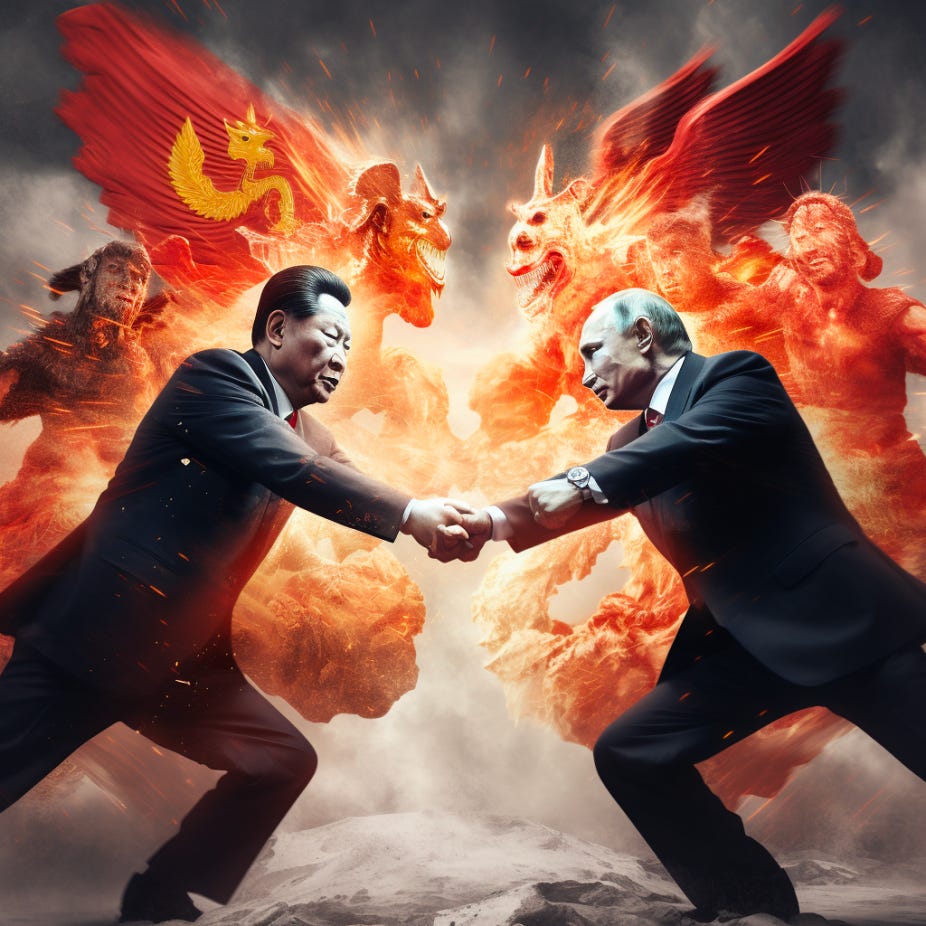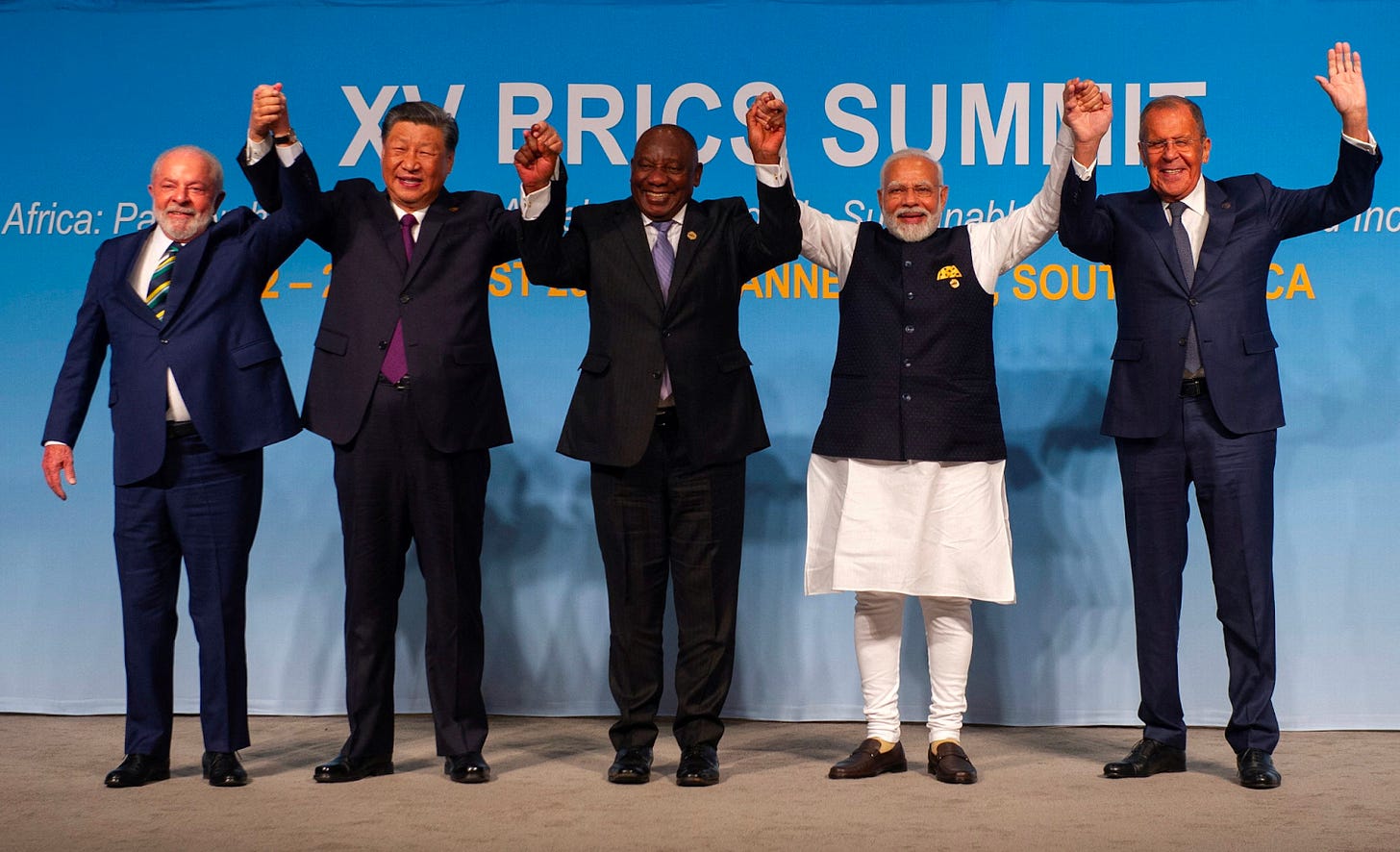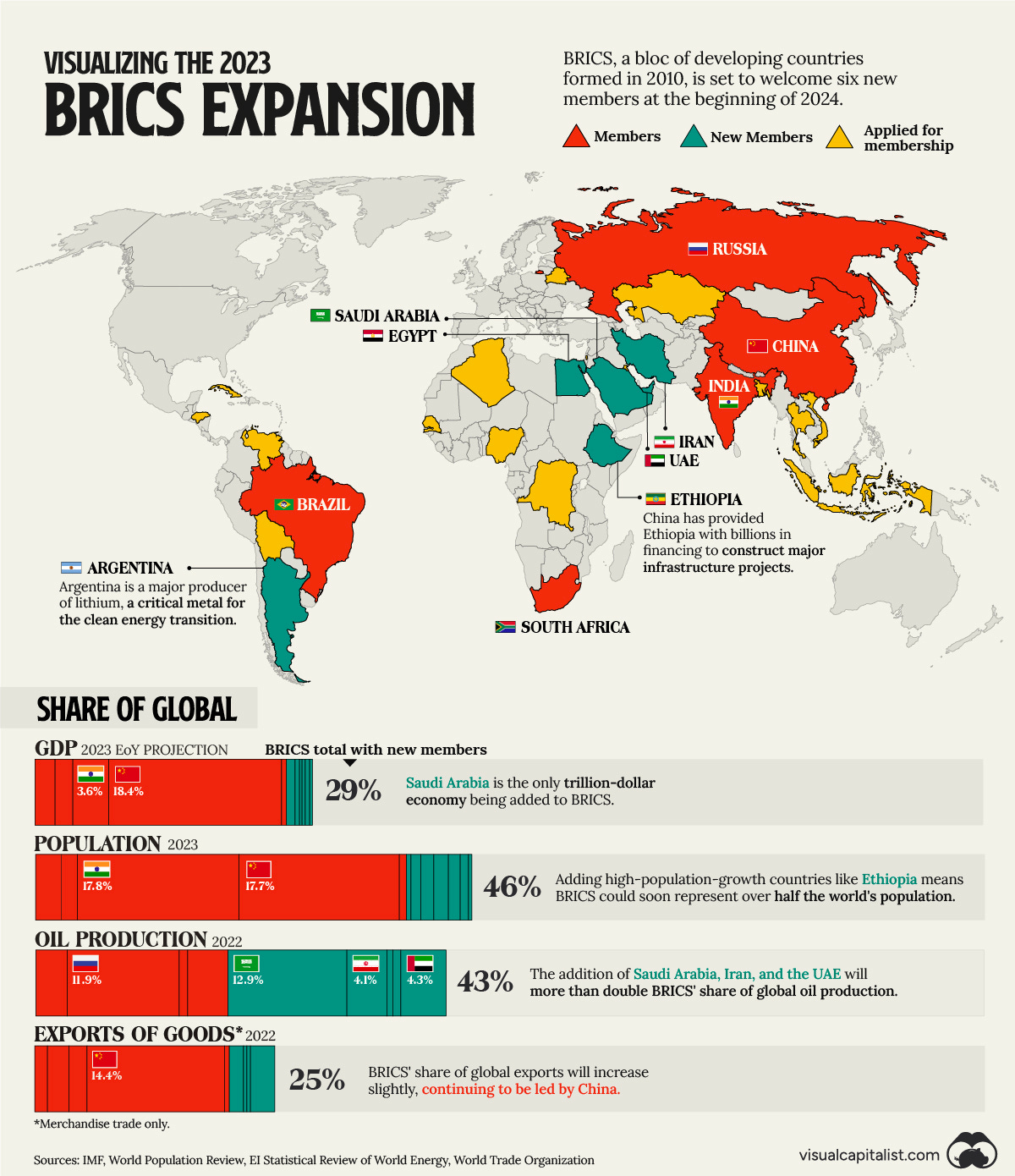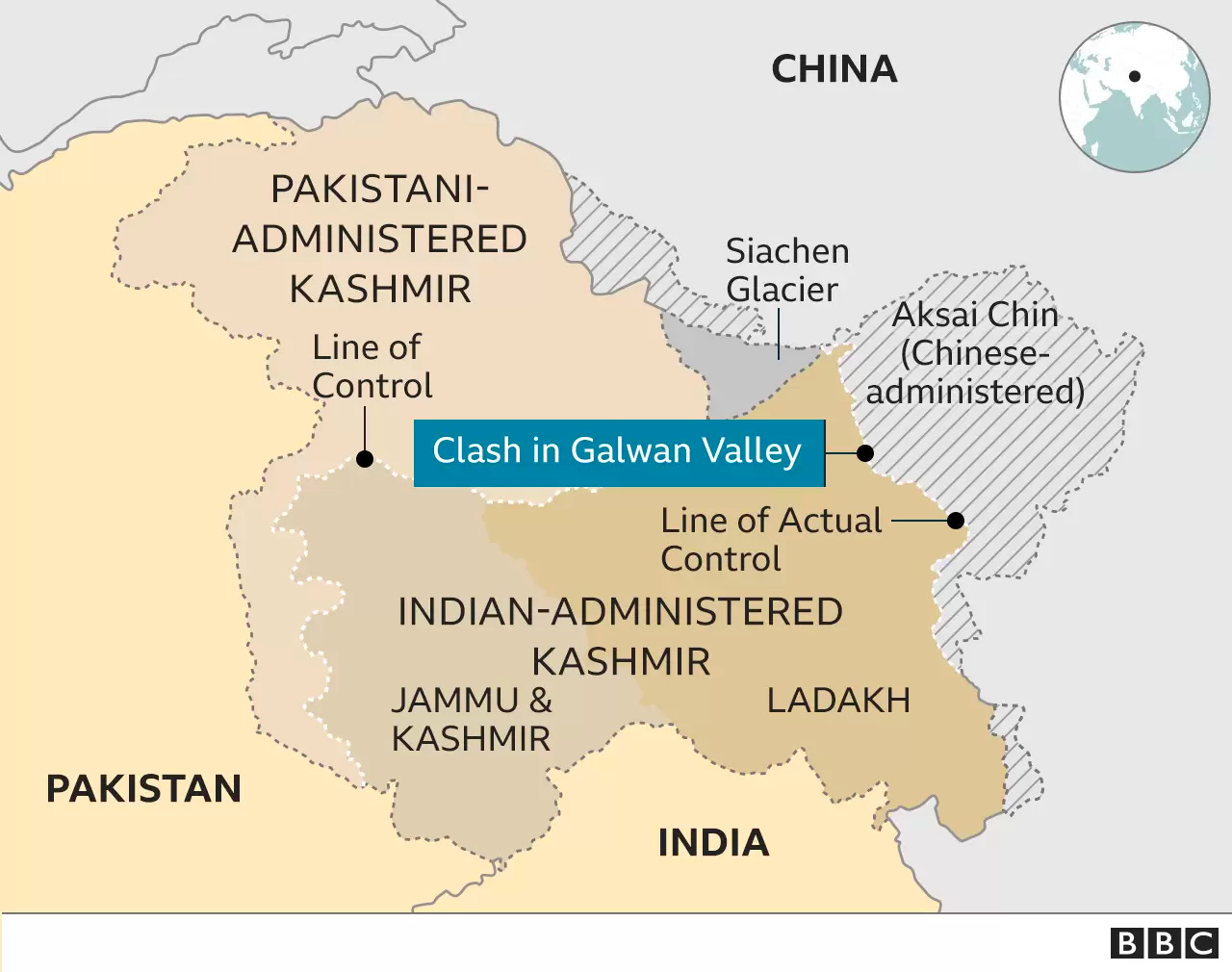

Between August 22-24th, the coalition of countries known as BRICS met in Johannesburg, South Africa for their 15th annual summit. BRICS, standing for Brazil, Russia, India, China, South Africa,
BRICS is expanding. But could it actually pose a threat to Dollar Hegemony?

Between August 22-24th, the coalition of countries known as BRICS met in Johannesburg, South Africa for their 15th annual summit. BRICS, standing for Brazil, Russia, India, China, South Africa, was originally formulated in the mind of a Goldman Sachs economist, Jim O’neil, in 2001 in an economics paper describing the future of the global order, giving examples of new rising powers who could potentially compete with current superpowers for resources.
A few years after the paper gained popularity, the foreign ministers of the countries began organizing regular meetings to discuss economic integration, trade, and growth policy. In 2009, the countries formalized the process and created the BRICS summit. (Technically, South Africa joined in December 2010, and the acronym was BRIC before that.)

Collectively, these burgeoning markets encompass 42% of the global population and contribute to more than 31% of the world's GDP. BRICS was initially touted as a potential alliance, a federation of sorts that could combine forces to challenge the economic behemoth that is the United States. However, they quickly began running into issues. Noah Smith explains-
In 2009 [the BRICS] started meeting regularly and trying to think about how to create their own economic institutions — a New Development Bank to compete with the World Bank, a Contingent Reserve Arrangement to lend each other money in times of currency crisis (something the IMF usually does), a system of submarine fiber-optic cables, and so on.
This, too, did not end up working out. The New Development Bank has disbursed almost no loan money at all, causing Jim O’Neill to declare it a disappointment. When Russia invaded Ukraine in 2022, the NDB cut ties with it. The Contingent Reserve Arrangement has done basically nothing, and the BRICS Cable never happened.
BRICS has inherent flaws. Not the least of which are the competing and often mutually exclusive interests of the powers that make up the quasi-alliance- meaning that it is incredibly difficult to get anything concrete done because that requires consensus on the nation state level by veritable autocracies like Russia and China.
Picture the difficulties inherent in a bureaucracy- bartering and compromise, finding shared values and beliefs, reaching consensus on rules and regulations, and then enforcement of said structure. The United States Senate is made up of all American citizens, mostly Boomers over the age of 50, millionaires, and majority white. However, even with this demographic homogeneity, the Senate has been achieving lower rates of success in passing bills for the last decade.
Conflicting interests, financial and economic incentives, ideological blindness and more plague this American institution.
Why would BRICS be any different?

Yet, BRICS clearly does represent a strong desire to leave the stranglehold that America holds over the global financial system. This desire is gaining strength, as this year the number of member applications has soared to 22 and powerful allies of the United States such as Saudi Arabia have flirted with joining the coalition. As Navdeep Suri, Distinguished Fellow at Observer Research Foundation (India) lays out-
The fifteenth BRICS summit has gone further than any other in the recent past to modernize and galvanize the grouping. It has sent a strong signal that the post–World War II order should accept the multipolar reality and change with the times.
The slew of applications to join the BRICS is clearly a symptom of a deeper malaise. The West’s proclivity to deploy unilateral financial sanctions, abuse international payments mechanisms, renege on climate finance commitments, and accord scant respect to food security and health imperatives of the Global South during the pandemic are only some of the elements responsible for the growing disenchantment with the prevailing international system.
The expansion of the BRICS to a BRICS+ format and the adoption of guiding principles, standards, and procedures for the same, have potentially made the BRICS a more attractive institution for consensus-building and dialogue in the developing world. Even the profile of the new members suggest that the system is headed for something beyond traditionally “acceptable” partners in the eyes of the West.
The membership requirements were one of the agenda items to be covered in the meeting, with the incumbent 5 nations laying out a framework for joining and a set of expectations for other nations to meet once they are accepted. Of the 22 new member applications, basically all have come as of 2023, as fallout continues from global supply chain disruptions and the U.S. sanctioning of Russia at the onset of the Ukraine War.
More than 40 nations, such as Iran, Saudi Arabia, the United Arab Emirates, Argentina, Algeria, Bolivia, Indonesia, Egypt, Ethiopia, Cuba, the Democratic Republic of Congo, Comoros, Gabon, and Kazakhstan, have conveyed their eagerness to participate in the forum, as stated by South Africa, the host of the 2023 summit.

As we said, the desire is clearly there… So what's next?
Agreements are made, documents signed, discussions are held, and yet… nothing. No common currency, no military coalition, no coordinated default on US dollar debt obligations.
A new fiat currency created by BRICS and backed by commodities, it was proposed, would lead to rampant flight out of US dollars and into their new reserve asset. However, realistically, that isn’t going to happen. At least not with another fiat.
A global reserve currency must have several features:
Brent Johnson adds onto this list with a very poignant observation made on a Blockworks podcast on April 21st.
“Typically the country that has the global reserve has one of the biggest markets in the world. Historically that's kind of been the case and if you and you typically countries around the world will want to do business with the global superpower right and if you're going to do business with the global superpower again whether it's Britain or the United States or France or whoever it is at the time you're going to use their currency right and so the reason [...] that people around the world would accept dollars is because it was in great demand around the world. One of the definitions for money is the most marketable commodity which means it has the most liquidity and it's just a fact that the US dollar had the most liquidity around the world compared to all of the Fiat currencies”
Simply put, no other fiat has deeper, more liquid and more stable financial markets than the U.S. Dollar. (Remember we are talking relatively here). And it’s basically impossible for any fiat to grow enough to challenge American hegemony. Why?
Well, to switch reserve currencies, there must be a compelling reason to do so, as this means trillions of dollars and monetary stability changes on a global scale. The usurper must have significant economic advantages and growing ability to facilitate trade, while the incumbent is in decline and decay. Generally, world reserve currency status has momentum, so it lasts a bit longer than the empire. This can easily be seen in the most recent reserve currency transition from the British Pound to the U.S. dollar.
Despite a declining global empire, the loss of hundreds of British men, and growing independence movements in her colonies, Great Britain still held onto reserve currency status until 1944 at Bretton Woods. It took a genuine crisis to push the world off the Pound Standard and onto a Dollar one.
Not only that, but the replacement currency had definite advantages over the Pound, which helped draw more nations into the fold.
As it currently stands, no nation alone could challenge U.S. hegemony. Russia is an oil-based exporter with not much diversification in economic terms, China is declining demographically and has an authoritarian government with capital controls (which can’t be held onto if you want to become a WRC). Brazil, India and South Africa are all export based economies. These countries cannot sustain constant current account deficits and thus would need to switch their economies overnight if they wanted to gain WRC status. That isn't feasible.
And the combination of these countries is no better. Imagine all these nations, with different cultures, histories, traditions, governments, and monetary policies all trying to band together and manage ONE currency with a single monetary policy.
What if there’s a deflationary crisis in China as the property market unwinds concurrent with an inflation surge in India due to rising commodity prices? A financial crisis in Russia with a export ban in Brazil?
Not even to mention that two of the major powers in the alliance, China and India, are currently at odds with significant border disputes in the Himalayas. Soldiers on both sides have clashed dozens of times, leading to injuries and deaths. Both countries have moved military equipment into several areas along their shared border, which spans more than 3,440 kilometers (2,100 miles). The primary points of contention are:
1. Aksai Chin: China controls this region in the western sector, which India claims as part of the union territory of Ladakh.
2. Arunachal Pradesh: India administers this northeastern state, but China asserts sovereignty over it, referring to it as "South Tibet."
The dispute has resulted in several armed skirmishes over the years, with the most notable being the Sino-Indian War of 1962. Since then, both countries have maintained a fragile ceasefire, but tensions have periodically flared up, leading to border standoffs and occasional military clashes, ironically mostly with clubs, pikes and sticks.
The situation in the region is complicated by strategic and geopolitical factors, as well as competing territorial claims, making it a source of ongoing tension between China and India. Both countries continue to patrol and assert their claims in the disputed areas, which can lead to periodic escalations.

How would BRICS deal with the complexities inherent in running a reserve currency while these tensions simmer under the surface? What if China agreed to give up the border dispute in order to get easy monetary policy to ease their housing pains, but then reneged on their promise?
What would the rules be in this new quasi-UN/ECB institution? And who enforces the rules? A bureaucratic board of conflicting interests would essentially decide on nothing and go nowhere. If anything, the strongest nations would assert their dominance and leave basically no reason for the weaker nations to even stay.
No, a BRICS currency as currently conceived is a pipe dream. A fantasy. All the issues inherent in the U.S. dollar system would only be more true of a BRICS currency. The only thing that unites the BRICS nations is opposition to the current predatory (but efficient and useful) dollar standard.
A common enemy can create the strangest of bedfellows.
A new reserve currency would emerge not only because the U.S. is in decline and strong demand exists for an alternative (both are true) but also because the new currency is better in some way than what currently exists.
Much has been made of the in
creasing demand for gold (2022 saw the highest amount of gold purchases by global central banks in history) but a return to a gold standard is not a viable idea. In the modern technocratic internet age, money needs to move as fast as information does- and thus a slow, heavy and physical form of money simply won’t do. I will dive into this in more depth in a later article, but I think a return to a true gold standard is one of the most unlikely options post the death of the global eurodollar system.
Gold would inevitably wind up in banks, exchanged for digital units of account to represent the gold which are used for trade. This puts us right back where we started.
Bitcoin essentially is the only real solution here. A decentralized, permissionless, non-state issued currency that can cross borders easily and (relatively) quickly. Large transactions can be done on the baselayer while smaller transactions (which make up 99% of volume) can be done via Lightning.
Bitcoin is clearly better money than the dollar in terms of store of value, and unit of account (given that dollars are not equal everywhere, as the Treasury can freeze accounts, even ones located outside American borders) but it fails in one respect- liquidity.
As it currently stands, the Bitcoin market is simply way too small to handle the large volumes and swings in price pressures that a global reserve currency faces. Scaling will need to be done gradually and liquidity will need to grow significantly to handle the size of the transactions. This may not sound like sexy or fun work, but it’s necessary if the orange coin has intentions of ever getting taken seriously on a global stage.
Things will change much faster than most people think once BRICS and other nation-states in the global south realize this and begin the transition.
Slowly, then all at once.
Originally written on Dollar End Game